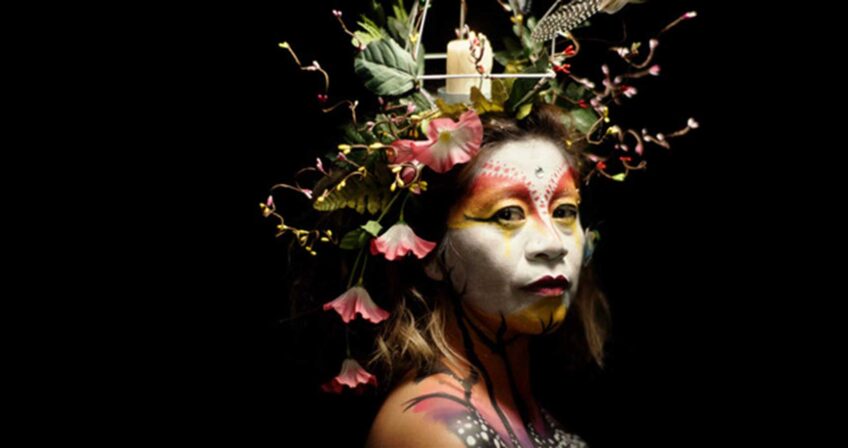
“Arlene Shechet: All at Once” is a captivating exhibition at the Institute of Contemporary Art/Boston through Sept. 7 that unfolds as a series of surprises.
At first glance, its introductory gallery does little to raise expectations. As if wandering into an elementary school art workshop, the visitor encounters a roomful of rough-hewn, white plaster figures. On the walls are framed blue and white works on paper that call to mind tie-dyed T-shirts from the ‘60s.
But walk around and a sense of calm slowly grows as you view the plaster figures, Buddhas of various shapes and sizes mounted on a multi-tiered platform evoking a temple in a Himalayan hill town. The framed works become meditative tools too, mandalas with circular forms echoing the cycle of life, death and rebirth in Buddhist teaching. Each work on paper is a design for a stupa, a space for meditation. Inducing the visitor to walk around and view the various works, Shechet’s room-size installation itself is a stupa.
Created between 1993 and 2000, these are early works in this loosely chronological 20-year oeuvre of Shechet, a New York-based sculptor. They were inspired by the artist’s formative visit a decade earlier to 9th-century Buddhist temples in Indonesia.
Organized by Jenelle Porter, ICA senior curator who also developed its catalog, the exhibition presents more than 150 objects that follow Shechet’s interwoven interests and influences along with her exploration of Western and Eastern traditions.
Shechet orchestrated the entire exhibition piece by piece and room by room, a form of installation art that invites visitors to share her discoveries as she turns her materials — plaster, glass, porcelain, paper pulp and clay — into solid objects.
Improvisational in her approach, Shechet has over the past decade been drawn to clay, enjoying its responsiveness to hands-on kneading as a “mushy substance” before it hardens into an object.
Surface and soul
As visitors progress through the exhibition, the works trigger an ever-increasing sense of joy and lightness. Interested in shaping space as well as objects, Shechet allows ample room to move around the works and peer into their folds and curves. Mounting works on wood, metal, kiln bricks and other materials of varied heights, the installation coaxes people to look up and down as well as walk around as they examine the sculptures.

Author: Charles MayerA sculpture from the exhibit.
Shechet’s semi-abstract figures loosely resemble other things, conjuring both personal memories and shared histories. Her artmaking tools include not only physical materials but also words. Like whispered asides, her titles nudge associations and let a viewer in on the jokes.
In the second gallery, a raised shelf displays rows of cast porcelain vases in varied shades of black and white. Entitled “Building” (2003), the installation, a 9/11 memorial, resembles a miniature city of cremation urns.
Sharing the gallery is a group of Shechet’s mouth-blown crystal works, stacked cylindrical vessels that resemble lanterns. Shechet made the first of these pieces in 2004. Then, turning to clay, she continued to explore breath as a tool to shape objects.
In the next gallery, which extends the entire length of the ICA’s fourth floor exhibition space, 25 sculptures are on display. The first group suggest clouds, smoke and other airborne forms.
Some are coated with thick, shimmering glazes. Apertures protrude, inviting closer inspection, along with shiny folds glistening with liquid-like pigment. Colors vary from unpainted surfaces to sunny, iridescent pastels laden with glitter. Textures, seldom smooth, may evoke volcanic lava or sea foam. Making the innards of her workmanship visible, Shechet works kiln bricks and other studio apparatus into her sculptures.
Shapes and icons
In later works, Shechet piles and wraps braided coils of clay into organic shapes. Some mimic natural elements, such as “Because of the Wind” (2010). Coated with a finish that resembles suede, its bundle of coils and pigment-speckled kiln bricks intertwine into a wind-swept figure. The flabby, flesh-toned “No Noise” (2013) resembles a bagpipe.
Other works suggest cultural icons. Shechet’s tilting sculpture “My Balzac” (2010) parallels the backward-leaning 1898 bronze figure by Auguste Rodin of revered French novelist Honoré de Balzac.
Exalting humble materials in her semi-abstract works, the exhibition also includes a gallery of framed bas-relief works in painted paper pulp, including the sublime “Worldview” (2012), a masterful mingling of color, texture and form.
In a small side gallery resides an elegant salon that showcases works from Shechet’s yearlong residency at the Meissen Porcelain Manufactory in Germany. Founded in 1710, Meissen introduced lifelike porcelain to Europe and quickly gained renown for its baroque figurines and dinnerware. Just as Shechet deconstructs the elements of her studio process, inserting bricks, molds and studio flotsam into finished works, her Meissen projects turn the factory’s molds and shards into finished works.
While flaunting an off-kilter free spirit, Shechet’s pieces are as highly refined as the historic originals also on display in the gallery. Ornate flowers and fragments cling like barnacles to her fantastical ivory vase. Feet painted with gilded flowers peak from an upside down ballerina’s skirt along with a flower, a snake and a bird. At the entrance to this jewel of a gallery, which gently spoofs the porcelain display rooms of 18th-century gentry, a 100-year-old black and white silent film shows costumed performers and their dog posing as figurines.
Here and throughout the exhibition, Shechet’s works demonstrate that art gains life not as a static object but rather in the mingling of imaginations between artist and viewer.






